
Wallachia or Walachia is a historical and geographical region of modern-day Romania. It is situated north of the Lower Danube and south of the Southern Carpathians. Wallachia was traditionally divided into two sections, Muntenia and Oltenia. Dobruja could sometimes be considered a third section due to its proximity and brief rule over it. Wallachia as a whole is sometimes referred to as Muntenia through identification with the larger of the two traditional sections.

The Kingdom of Romania was a constitutional monarchy that existed from 13 March (O.S.) / 25 March 1881 with the crowning of prince Karl of Hohenzollern-Sigmaringen as King Carol I, until 1947 with the abdication of King Michael I and the Romanian parliament's proclamation of the Romanian People's Republic.
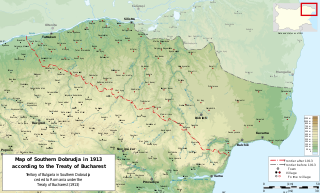
The Treaty of Craiova was signed on 7 September 1940 and ratified on 13 September 1940 by the Kingdom of Bulgaria and the Kingdom of Romania. Under its terms, Romania had to allow Bulgaria to retake Southern Dobruja, which Romania had gained after the 1913 Second Balkan War. Bulgaria had to pay 1 million lei as compensation for the investment provided to the region by Romania.

The Kingdom of Romania was neutral for the first two years of World War I, entering on the side of the Allied powers from 27 August 1916 until Central Power occupation led to the Treaty of Bucharest in May 1918, before reentering the war on 10 November 1918. It had the most significant oil fields in Europe, and Germany eagerly bought its petroleum, as well as food exports.

The Flămânda Offensive, which took place during World War I between 29 September and 5 October 1916, was an offensive across the Danube mounted by the Romanian 3rd Army supported by Romanian coastal artillery. Named after the hamlet of Flămânda, the battle represented a consistent effort by the Romanian Army to stop the Central Powers' southern offensive led by August von Mackensen. The battle ended as a tactical victory for the Central Powers.

The union of Transylvania with Romania was declared on 1 December [O.S. 18 November] 1918 by the assembly of the delegates of ethnic Romanians held in Alba Iulia. The Great Union Day, celebrated on 1 December, is a national holiday in Romania that celebrates this event. The holiday was established after the Romanian Revolution, and celebrates the unification not only of Transylvania, but also of Bessarabia and Bukovina and parts of Banat, Crișana and Maramureș with the Romanian Kingdom. Bessarabia and Bukovina had joined with the Kingdom of Romania earlier in 1918.
The Royal Romanian Navy during World War I (1914–1918) was divided into two fleets and fought against the forces of the Central Powers. When Romania entered the war in August 1916, the Romanian Navy was officially divided as follows :
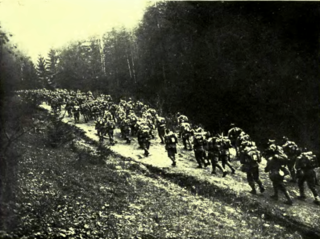
The Battle of Transylvania was the first major operation of Romania during World War I, beginning on 27 August 1916. It started as an attempt by the Romanian Army to seize Transylvania, and potentially knock Austria-Hungary out of the war. Although initially successful, the offensive was brought to a halt after Bulgaria's attack on Dobruja. Coupled with a successful German and Austro-Hungarian counterattack which started in mid-September, the Romanian Army was eventually forced to retreat back to the Carpathians by mid-October. The Romanian armies however managed to escape the Central Powers' attempts to completely destroy them. The Battle of Transylvania also caused the replacement of the Chief of Staff of the German Army and the shifting of German attention to the region, causing German offensive operations at Verdun to cease.
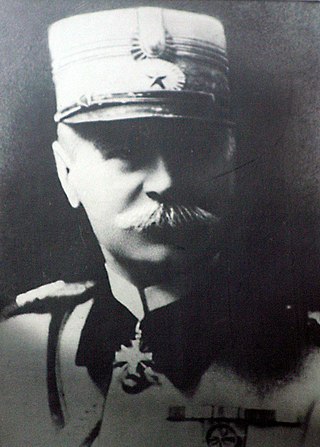
Gheorghe D. Mărdărescu was a Romanian army major general during World War I, a commander during the Hungarian–Romanian War of 1919, and Minister of War from 1922 to 1926.

Ioan or Ion Bianu was an Imperial Austrian-born Romanian philologist and bibliographer. The son of a peasant family from Transylvania, he completed high school in Blaj, where he became a disciple of Timotei Cipariu and Ioan Micu Moldovan. As a youth, he espoused Romanian nationalism, and came into conflict with the Austro-Hungarian authorities, before finally emigrating to the Romanian Old Kingdom in 1876. There, he attended the University of Bucharest, later joining the faculty, where he taught Romanian literary history. He was affiliated with the Romanian Academy Library for over half a century, transforming the institution from the meager state in which he found it, and overseeing a five-fold increase of its collection. He helped author two important multi-volume works detailing early books and manuscripts from his country, and was a founder of library and information science in his adoptive country. Near the end of his life, struggling with deafness, Bianu withdrew from the Library in favor of his friend Radu R. Rosetti, but went on to serve as president of the Romanian Academy.

NMS Grivița was a gunboat of the Romanian Navy, built in 1880. It was the first warship acquired by the Kingdom of Romania after gaining independence in 1878 and the first military ship of the Romanian Black Sea Fleet. Throughout her career, she saw service on both the Black Sea and the Danube during the Second Balkan War and the First World War.

NMS Mihail Kogălniceanu was a Brătianu-class river monitor of the Romanian Navy. She saw service in both world wars, being the most successful vessel in her class of four ships. Like her three sisters, she was initially built as a river monitor, but in early 1918, she was converted to a sea-going monitor. During the Second Balkan War, she supported the Romanian crossing of the Danube into Bulgaria. During World War I, she carried out numerous bombardments against the Central Powers forces advancing along the shore of the Danube and carried out the last action of the Romanian Navy before the 11 November 1918 armistice. She later fought successfully against Bolshevik naval forces during the early months of the Russian Civil War, helping secure the Budjak region.

The Raid on Ruse was the first naval action to take place on the Romanian front during World War I. It took place on the first day of the campaign, 27 August 1916, just as Romanian troops were crossing the border into Transylvania, then part of Austria-Hungary.

Ioan Popovici was a Romanian general and commander of the Romanian 1st Army Corps from 1916 to 1918 during World War I.

After a series of quick tactical victories on the numerically overpowered Austro-Hungarian forces in Transylvania, in the autumn of 1916, the Romanian Army suffered a series of devastating defeats, which forced the Romanian military and administration to withdraw to Western Moldavia, allowing the Central Powers to occupy two thirds of the national territory, including the state capital, Bucharest.
The foreign policy of Romania in the years preceding the outbreak of World War I was characterized by the nation's need to contend with the rise and shifting rivalries of the Great Powers of the pre-war era. Its primary objectives were to maintain its territorial integrity and maintain friendly relations with neighboring nations. This culminated in Romania secretly joining the Triple Alliance in 1883. However, the nation would later reverse course, declaring neutrality for the first two years of the war before entering on the side of the Triple Entente in 1916.
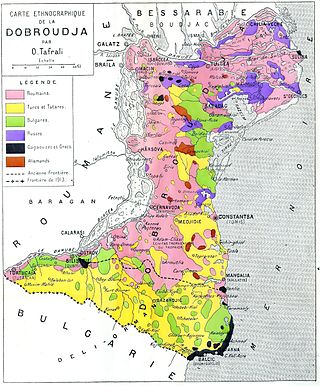
The population exchange between Bulgaria and Romania was a population exchange carried out in 1940 after the transfer of Southern Dobruja to Bulgaria by Romania. It involved 103,711 Romanians, Aromanians and Megleno-Romanians living in Southern Dobruja and 62,278 Bulgarians from Northern Dobruja. After this operation, the application of a population exchange in other cases such as Transylvania was considered.

Dobruja Day is a holiday of Romania celebrated every 14 November that commemorates the incorporation of the region of Northern Dobruja into Romania on 14 November 1878.

The Trianon Treaty Day is a holiday in Romania celebrated every 4 June to commemorate the signing of the Treaty of Trianon in 1920. The holiday was first proposed in 2015 by the Romanian politician Titus Corlățean and subsequently promulgated on 18 November 2020 by President Klaus Iohannis.
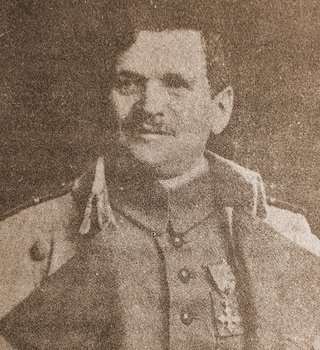
Marcel Olteanu was a Romanian brigadier general during World War I and the Hungarian–Romanian War.



















